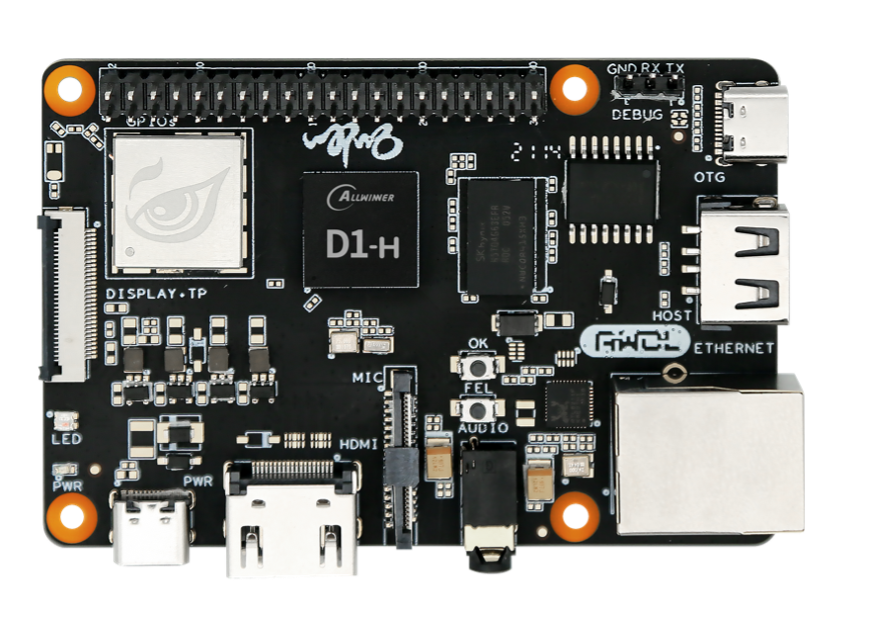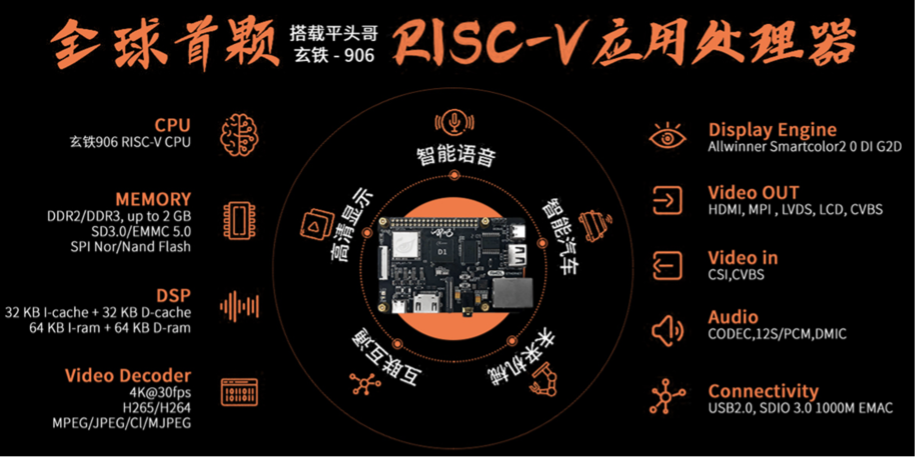In the first RISC-V World Conference in China hosted at Shanghai on June 2021, my colleague and friend, Wei Gao (Gavin), and I gave a speech of “Autonomous Management of Edge Applications on RISC-V & Heterogeneous Edge Environment”, introducing what we have been doing to enable the Edge Computing management capabilities on RISC-V architecture infrastructure by using Open Horizon, an open source project within the Linux Foundation’s LF Edge umbrella organization.
When we delivered the above topic, we didn’t have a real RISC-V device in hand and were still using QEMU simulator to develop the prototype of enabling Open Horizon to support RISC-V architecture. With the helps from Wei Fu, Senior Software Engineer at Red Hat and RISC-V International Ambassador at China, and Wei Wu, PLCT Lab Director at Chinese Academy of Sciences, we were so excited to get one Nezha (哪吒) 64-bit RISC-V SBC (Single Board Computer) mailed by Wei Wu last Dec.. Thanks so much Wei Wu and Wei Fu!
In the past few months, we’ve spent some spare time setting up the Nezha board, installing Fedora Linux, bringing up the docker env, and now working on building an edge computing playground based on Nezha RISC-V SBC and Open Horizon technologies. Although we’re still in the process of refining the design and constructing the playground in our spare time to address different scenarios, I’d like to share what we have been doing so far and lessons learned from time to time, as our working notes which I hope are helpful for you too if you want to learn or play with these technologies by yourself.
In today’s blog, let me give you a briefing firstly on what are Open Horizon, RISC-V and Nezha SBC, and why we want to build this playground around them, before I summarize what we have done to set up the Nezha SBC, install and configure Fedora Linux, docker and Open Horizon on it. I’ll keep you updated once we have more fun and learn more in our journey of constructing the Edge Computing Playground built on top of Open Horizon+RISC-V technologies.
Open Horizon is an open source platform designed for deploying containerized workloads and related machine learning assets to distributed edge computing nodes and managing their software lifecycle, securely and at extreme scale. What makes Open Horizon different from cloud-out edge solutions is its edge-native, decentralized and autonomous design, through distributing its control to each edge node, rather than centralizing it. There is a lightweight autonomous agent running on each edge node, initiating encrypted communications, and negotiating what workloads to run locally, based on the policies specified during the device registration with a minimal central management hub. We will share with you more details of Open Horizon capabilities and differentiations with some playground demos in the future posts. (btw, you can also find Open Horizon documentation in Chinese from this link, which we’re still improving.)
RISC-V was designed by the University of California, Berkeley, and now is a free and open ISA (Instruction Set Architecture) governed by RISC-V International, a global nonprofit association based in Switzerland, founded in 2015, with 2k+ members in more than 70 countries so far. RISC-V is a free and open ISA, enabling a new era of processor innovation through open standard and open source collaborations. The open RISC-V ecosystem has been growing so fast globally and the most recently Intel joined RISC-V International as the Premier member and makes deep investment in RISC-V Community. In China, RISC-V community has been booming quickly. So far, around half of the RISC-V International Premier Members are from China. 中国RISC-V产业联盟(China RISC-V Industry Consortium (CRVIC)) and 中国开放指令生态联盟 (China RISC-V Alliance (CRVA)) are the two major non-profit organizations in China to drive the RISC-V related technology and business development and collaborations across more than 100 members in China.
The Nezha SBC is a RISC-V single board computer, produced by Allwinner Technology (全志科技). The core of the board is Allwinner D1 SoC based on Alibaba T-head’s RISC-V-based XuanTie C906 core. You can get the detailed specs about Nezha SBC from this link: https://d1.docs.aw-ol.com/d1_dev/ (Sorry, many in Chinese, but you can get the key specs from this picture.)
With the evolving and explosive growth of Edge Computing and convergence of IoT, 5G, AI, Edge and Cloud technologies, it creates a lot of imaginations and possibilities to integrate and innovate the current technologies and drive the digital transformation across the industries. Meanwhile, it brings more growth opportunities and broader ecosystem for RISC-V as one of the most promising IoT and edge computing infrastructures, with the advantage of cost, flexibility, customization for purpose, and open source innovations and ecosystem, compared with the current mainstream architecture of ARM and x86.
However, how do you manage and secure a topology with hundreds of thousands of edge devices on RISC-V and other architectures in a heterogeneous environment? How to get the right edge applications and related machine learning assets onto the right edge devices autonomously in a cost-effective manner? And, with more open source and commercial projects emerging to address similar or different concerns around Edge computing, it creates silos among these technologies and also brings troubles to choose and integrate them properly to implement an end-to-end Edge solution to address both of the common and specific needs of different industry scenarios. When ABCDE (AI/Blockchain/Cloud/Data/Edge) plus the 5G/Network meet together, they will work as the catalyst for each other to generate more innovations on the way to disrupt the IT and digital transformation for business. There are so many exciting areas, challenges, and uncertainties for us to learn, explore, and have fun with community members, which is the reason why we want to build this edge computing playground around Open Horizon, RISC-V, and more in the future.
Ok, let’s stop here for today. In the next post, I will bring you to our Day 1 when we set up the Nezha SBC for running Open Horizon. Stay tuned! 😊
(The paper is also available in https://www.linkedin.com/pulse/open-horizonrisc-v-edge-computing-playground-david-yao/ )

